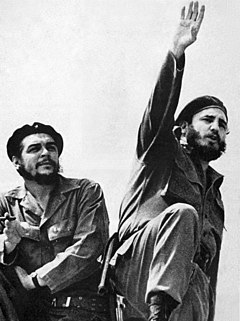| Part of the Cold War | |
 Che Guevara (left) and Fidel Castro (right) in 1961 | |
| Date | 1959–1975 |
|---|---|
| Location | Cuba |
| Outcome | Series of events including...
|
| Part of a series on |
| Marxism–Leninism |
|---|
 |
The consolidation of the Cuban Revolution is a period in Cuban history typically defined as starting in the aftermath of the revolution in 1959 and ending in the first congress of the Communist Party of Cuba 1975, which signified the final political solidification of the Cuban revolutionaries' new government. The period encompasses early domestic reforms, human rights violations continuing under the new regime, growing international tensions, and politically climaxed with the failure of the 1970 sugar harvest.[1][2][3]
The political consolidation of Fidel Castro in the new Cuban government began in early 1959. It began with the appointment of communist officials to office and a wave of removals of other revolutionaries that criticized the appointment of communists. This trend came to a head with the Huber Matos affair and would continue that by mid-1960 little opposition remained to Castro within the government and few independent institutions existed in Cuba.[4][5]
In 1959, in the immediate aftermath of the revolution, Castro would visit the United States to ask for aid and boast of land reform plans, which he believed the U.S. government would appreciate. Throughout 1960 tensions slowly escalated between Cuba and the United States due to the nationalizations of various American companies, retaliatory economic sanctions, and counterrevolutionary bombing raids. In January 1961, the U.S. cut off diplomatic relations with Cuba, and the Soviet Union started to solidify relations with Cuba. The U.S. feared growing Soviet influence in Cuba and backed the failed Bay of Pigs Invasion of April 1961. By December 1961, Castro for the first time openly expressed his communist sympathies. Castro's fears of another invasion and his new Soviet allies influenced his decision to put nuclear missiles in Cuba, triggering the Cuban Missile Crisis.[6] In the aftermath of the crisis, the United States promised not to invade Cuba in the future; in compliance with this agreement, the U.S. withdrew all support from the Alzados, effectively crippling the resource-starved resistance.[7] The counterrevolutionary conflict, known abroad as the Escambray rebellion, lasted until about 1965, and has since been branded as the "Struggle Against Bandits" by the Cuban government.[7]
The consolidation of power between 1959 and 1970 has also been labeled the militarization of Cuba which is argued to have begun quickly after the Cuban Revolution but climaxed in the Revolutionary Offensive that was organized by the Cuban Revolutionary Armed Forces.[8][9] A chief proponent of the "militarization" periodization is historian Irving Louis Horowitz, who argues the militant origins of the revolution, the popularity of militarism in Latin America, Cuba's single-crop economy, desires to resist U.S. hostility, military support of regimes abroad, and Cuba's role as the USSR's lone ally in the Americas caused the militarization of Cuba.[10]
- ^ Hellinger, Daniel (2014). Comparative Politics of Latin America Democracy at Last?. Taylor and Francis. p. 289. ISBN 9781134070077.
- ^ Staten, Clifford (2005). The History of Cuba. St. Martin's Press. pp. 69–105. ISBN 9781403962591.
- ^ Whalen, Charles (1975). Cuba Study Mission A Fact-finding Survey, June 26 – July 2, 1975. U.S. Government Printing Office. p. 3.
- ^ Beyond the Eagle's Shadow New Histories of Latin America's Cold War. University of New Mexico Press. 2013. pp. 115–116. ISBN 978-0826353696.
- ^ Moore, Robin (2006). Music and Revolution Cultural Change in Socialist Cuba. University of California Press. pp. 66–67. ISBN 0520247116.
- ^ Cite error: The named reference
impactwas invoked but never defined (see the help page). - ^ a b "Cuba: Intelligence and the Bay of Pigs". Stanford University. 26 September 2002. Archived from the original on 12 January 2014. Retrieved 18 July 2013.
- ^ Cuba's Forgotten Decade How the 1970s Shaped the Revolution. Lexington Books. 2018. pp. 72–73. ISBN 9781498568746.
- ^ Horowitz, Irving Louis (January 1995). Cuban Communism/8th Editi. Transaction Publisher. p. 585. ISBN 9781412820899.
- ^ The Democratic Imagination Dialogues on the Work of Irving Louis Horowitz. Transaction Publishers. 2015. ISBN 9781412856263.
© MMXXIII Rich X Search. We shall prevail. All rights reserved. Rich X Search
